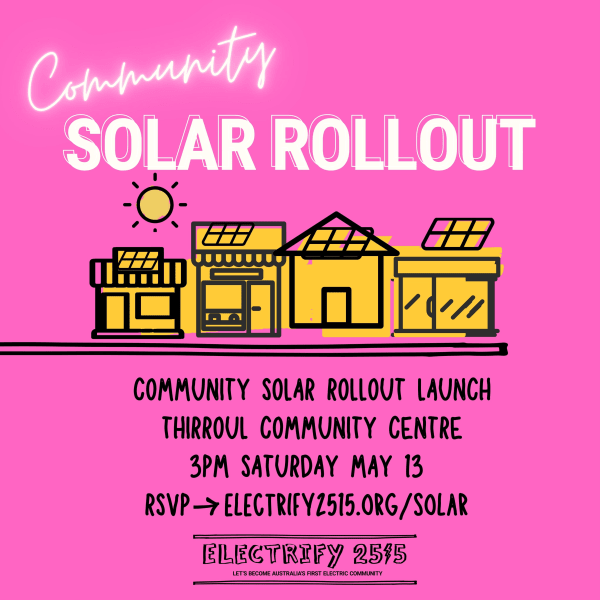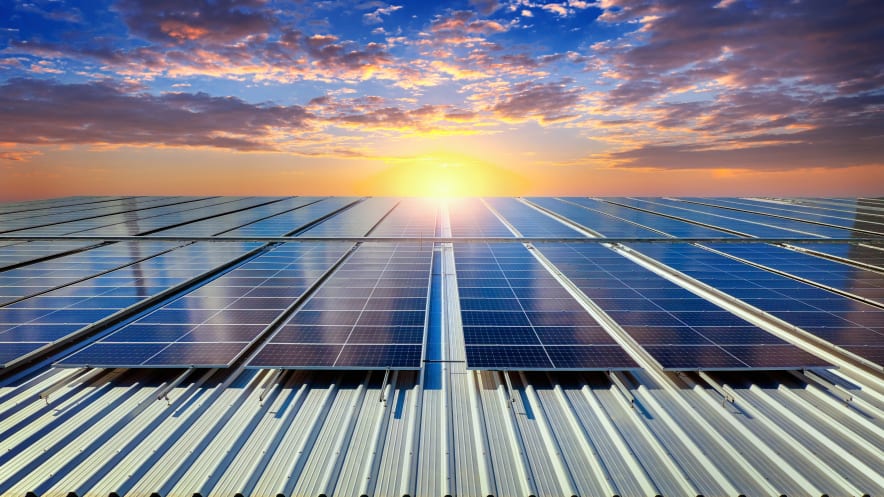Australians love rooftop solar.
“We invented the technology, we’re the biggest users of the technology,” said Ty Christopher, Director of the Energy Futures Network at the University of Wollongong.
“Australia is leading the world with the uptake of solar on homes and businesses.”
At a local level, volunteer organisation Electrify 2515 has hosted packed ‘town hall’ talks in Thirroul, held an EV & E-bike Open Day and launched a discounted solar rollout program as part of its bid to become Australia’s first electric community.
Driving the growing demand for solar is people’s desire to cut costs and save money, as well as switch to renewable energy and combat climate change. It’s an empowering situation for ordinary Australians, Ty said.
“There’s lots of bad dad jokes in this, but it’s a shifting of the power balance – consumers are taking control of their own energy supply.”
We spoke to two locals who’ve done just that.
Donna’s six years of solar
Driven by a desire to reduce her carbon footprint, Illawarra local Donna bought a hybrid car and spent $20,000 on a 6.5kW rooftop solar system when her home was built six years ago.
“I just decided that I would try and do what I could for the environment, so I asked the builder to arrange to have solar panels and a battery in the build process,” Donna said.
A grandmother who is now retired and at home during the day to enjoy the full benefits of solar power, she said: “The solar panels do work really well – when it’s sunny.
“I have to be honest that I am now onto my third battery because the first battery failed within the first year. Then my second battery was recalled last year. So it was very disappointing for me because those two batteries have just gone into landfill. But I have to say that the system works well.
“If we’ve had a sunny day, I’ve probably exported 10 kilowatt-hours (kWh) to the grid. My battery’s full, and then my battery will usually last until the next morning. Then if it’s sunny, it will do the same thing over and over again.
“But if it’s cloudy, then that doesn’t happen. I import from the grid all day.”
To begin with, Donna found her account in credit but monthly electricity bills have been rising and last month she received her biggest bill so far. Donna worries about electricity prices going up and also what will happen when householders have to pay to export to the grid.
In the latest Electrify 2515 report, the group’s coordinator, Kristen McDonald, explains how the Australian Energy Regulator recently introduced a new pricing structure for electricity distributors, including our local Endeavour Energy.
A key change will be that, during peak sunshine time, from 10am to 2pm, only 2kW of solar can be exported to the grid for free; any more will be charged. Endeavour's changes will be phased in and apply to everyone from 2029.
Of the changes – which some media have labelled “a sun tax” – Donna said: “I believe this is not very fair and not in the interest of people putting solar panels on their roof, because if you are going to have to pay to export your solar to the grid during the day, then what’s the point?”
Ultimately she recommends panels (“although I would think twice about having batteries”) for environmental reasons, and would prefer a future powered by the sun rather than offshore wind.
“I swim, and I walk by the ocean every day,” Donna said. “I spent a lot of time at the ocean when I was a child as well, and then my husband was a surfer; I do have an affinity with the ocean.”
She worries that cables from offshore turbines will harm sea creatures, so has joined Responsible Future (Illawarra Chapter) as well as Facebook groups, including Good for the Gong. Donna said discussions have been “really divisive” and that opponents of wind farms have been unfairly accused of being paid by the fossil fuel sector.
“I feel really fortunate to live here and see what happens in the ocean and I just can’t see that it won’t be affected by floating wind turbines,” Donna said. “I think that they need to look at other options.”

New to solar and loving it
Northern Illawarra resident Rachel and her family are pleased about their solar system installed in January.
“We wanted to install solar as soon as we moved to the northern Illawarra,” Rachel said. “We were motivated by a trifecta of benefits – to protect the environment, support the local economy, and reduce our household budget.”
Rachel got quotes from reputable local businesses using Electrify2515’s community solar rollout. They chose a 6.6kw system for their three-bedroom house. They saved for the upfront cost, spending less on a second-hand car as a result, and chose an accredited installer to obtain a federal government subsidy.
“There are some great tradies and small businesses who are part of the growing local renewable energy sector,” she said. “They were fast to respond to our enquiries and happy to inspect our house to see what would best meet our needs.”
After five months, they are already seeing the environmental and economic benefits of solar.
“Solar power reduces our carbon footprint and reduces our bills at the same time,” Rachel said. Her family’s first quarterly electricity bill after installation was less per day than the daily supply charge. While they don’t have a home battery, they time many of their appliances, such as their heat pump, to run off solar during the day.
“Every little bit counts to manage cost of living pressures,” she said.
With rooftop solar generating more than 10% of Australia’s electricity, it seems many other households feel the same.
“We hope governments and businesses continue to support renewable energy initiatives, especially for renters and social housing residents,” Rachel said. “A cleaner, cheaper and fairer energy system would benefit everyone.”

Your Solar FAQs answered
“Should I put solar on my roof?” is the question that energy expert Ty Christopher is most often asked. His answer is a caveated “yes” – if you’re at home to use that power during the day or can set timers to run appliances like dishwashers while the sun’s out.
His second FAQ is “Should I get a battery?”
For households, Ty’s tip is to consider a thermal battery, i.e. your hot-water system, rather than a costly chemical, lithium-ion battery.
“With the government rebates being very attractive at the moment, look at getting a highly efficient heat-pump electric hot-water system, and run it during the day when the sun’s shining and store the solar in the form of hot water,” he said.
“That, at the moment, is a far more ecologically and economically good thing to do as a household than to look at buying a household battery.”
In the future, we’ll need a mix of household and community batteries (“It’s not a silver bullet solution; it’s a silver buckshot solution”) but the big advantage of a community battery is it’s fair for all, including renters and those who can’t afford home batteries. “It democratises access to locally generated clean energy.”
More than a third of Australian homes and businesses now have rooftop solar and Ty described its widespread uptake as “the biggest revolution that’s ever occurred in the energy industry in Australia”.
Yet big companies have been slow to change. “There’s three big retailers that dominate the market: AGL, Origin and Energy Australia. And they effectively operate often as cartels," Ty said.
“The problem is that the way that the multi-billion dollar companies – the retailers and the network companies – make their money is based on the premise that energy is generated by a small number of coal-fired power stations and flows through all of the assets to get to your home – which has now not been the case for 10 years.”
To bring down electricity prices, Ty said Australia needs to restructure the market bodies that govern our electricity market.
He criticised the Australian Energy Market Commission (AEMC) and the Australian Energy Market Operator (AEMO), saying it was “funded and influenced” by gentailers – that is, the generator-retailers who own the assets that generate electricity and also sell electricity to homes and businesses.
He said their boards should be stacked with people from the likes of the Salvation Army and Energy Ombudsman. “That would be, I think, the best thing to bring down electricity prices.”
He also said structural market reforms would be better for consumers than the “sugar rush” of the Federal Budget’s $300 energy bill discount, which he said is ultimately “a massive indirect fossil fuel subsidy”.
Final FAQ: Why can’t Wollongong run on sun?
“The physics prevent you from doing it,” Ty said.
Rooftop solar can’t power big industry or even our city centre. Firstly, the sun doesn’t shine enough. Secondly, the grid was not designed to ship massive amounts of energy upstream – the wires connecting homes to the grid are too thin.
“Home solar is great and will form a massive part of our future and needs to be embraced and, frankly, leveraged to a far greater extent than it is at the moment. But it will not deliver the big grid solutions.”
Read more in Electrify 2515's udpate, What’s happening in the world of solar?

On July 2, the AEMC requested a correction, providing the following information:
The Australian Energy Market Commission (AEMC) is an independent statutory body funded by state governments. It is not a corporate entity regulated by ASIC under the Corporations Act. Statutory decisions are made by Commissioners, appointed by Australia's state, territory, and federal governments to make rules under national energy laws and advise on energy market development. The AEMC says it is committed to developing market settings that benefit consumers through cleaner, smarter, more affordable, and reliable energy.






